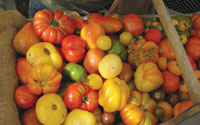
Fruit & Vegetable Report: Back to the Future
By Rosie Lombardi
Food Trends Sustainability consumer perception produce
Nor can assumptions be made that heirlooms are always more nutritious, says Roddy. “Some studies indicate the nutritional content of crops, measured within certain parameters, has gone down in recent years. But for every study that says one thing, there’s another that says the opposite because there are so many different factors to consider.”
Several categories of heirloom varieties that offer more flavour, colour and texture than their modern equivalents are growing in popularity with consumers. “Heirloom tomatoes, multi-coloured beets and carrots are the backbone of growers’ incomes,” says McCauley. Garlic, potatoes, and various greens such as kale and mesclun mixes are also catching on. Tomatoes top the list and are rapidly becoming mainstream, says DeCampo. “The dominant tomato doesn’t taste good, because it’s been bred so you can pick it dead green and ripen it with ethylene gas. Heirloom tomatoes are a great alternative to that, and there are hundreds of varieties.” But the way heirlooms are picked and shipped can nevertheless degrade their flavour too, warns DeCampo. “If you pick heirloom tomatoes before they’re ripe and put them in coolers to ship them, they won’t taste any better than other tomatoes.”
Flavour and nutrient values are greatly influenced by growing conditions, says Rosemary Wotske, co-owner of Poplar Bluff Farm, an organic farm based in Strathmore, Alta. “Mainstream carrots are bred to grow in sand. When we grow these varieties on our farm, the flavour is too much because the turpene levels are too high. We have to go back to old varieties that taste terrible grown in sand but are great in our heavier soil.”
Growers have a keen interest in heirlooms because they grow better in Canadian conditions, explains Wildfong. “There’s an undeniable logic that varieties which have originated in a certain region will grow reliably there. So we see some early 20th century varieties being used in their areas of origin simply because they grow well there.” Many growers are successfully using this historic appeal to market their produce, he says. “We’re seeing market gardens in Atlantic Canada using vegetable varieties that have been grown there for generations and marketing them on that basis.”
Why Should Processors Care?
Food producers and retailers in starting to use heirlooms in their offerings, according to DeCampo, who notes that “Chef Jamie Kennedy is developing a line of soups based on seasonal produce that will include heirlooms, and Fiesta Farms offers more diverse produce than Loblaws.” But for larger manufacturers, there are significant logistical and processing challenges to using heirlooms, since most of their equipment is designed to process large volumes of uniform crops. “Fancy heirloom potatoes of different sizes and shapes would be harder to process into french fries with machines,” says Wildfong.
Print this page